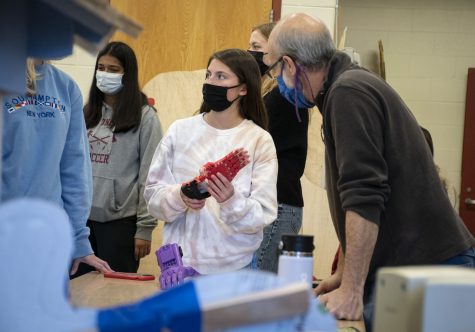Printing for Prosthetics builds handy devices
The Printing for Prosthetics Club met on Nov. 3, 2021. Pictured (left to right) are seniors Lilly Mitchell, Hayley Norton, Grace Morin, Caroline Kelly and junior Jula Utzschneider.
November 12, 2021
The Printing for Prosthetics club lends a hand to anyone who may be missing one by creating and donating artificial limbs.
Last year, seniors Hayley Norton and Caroline Kelly started the Printing for Prosthetics club after discovering the Enabling The Future Foundation, a non-profit organization that matches volunteers with children and adults in need.
Printing for Prosthetics works closely with the Robotics club, and they share club adviser Dan Strickland’s 3D printers. What makes Printing for Prosthetics different from Robotics is they print with skin-friendly plastics. Each limb is constructed with wires, Velcro and screws.
“The first few hands we made were [funded by] me and Hayley,” Kelly said. “But we wouldn’t be able to do it without the school’s printers. 3D printers are very expensive.”

The Enabling the Future Foundation has connected Norton and Kelly to individuals with missing limbs to donate their creations to. They strongly emphasize the importance of giving back to the community in this manner.
“We are able to print hands that actually work and know we make a difference in people’s lives,” Kelly said. “And [these recipients] don’t have to pay a penny.”
They can also create limbs at a fraction of the price of normal prosthetics. While prosthetics usually cost around $5,000, Printing for Prosthetics is able to make one for less than $100.
“[We make] this apparatus with something that’s very intricate and well-designed,” Norton said.
So far, funding the creations has proved troublesome, as the club relies heavily on donations from Norton and Kelly themselves, but that hasn’t been the sole issue in starting this club. The actual printing process has also brought challenges.
“With working with computers, technology and science, there are so many different steps and problems you have to tackle at once, like calibrating the printer and getting it to the right setting,” Norton said.
Norton, who is mainly responsible for printing, has devoted up to four hours a day just to calibrate the printer.

“That’s the science behind it that I actually liked, so I didn’t mind,” Norton said. “All you need to do is learn, so you can do it well.”
The co-founders find they’ve had great success so far, having built two hands and only one prototype. Recently, they received their first active case.
“It’s impressive that [the prosthetic] can work and can pick things up,” Kelly said. “You wouldn’t expect that some plastic with some wire could actually pick up things.”
Overall, Kelly and Norton agree that their favorite aspect of Printing for Prosthetics is the community that has gathered together to create these resources for people with missing limbs.
“I hope people realize we have the resources to [print],” Norton said. “Because anyone who wants to participate can… All you [have to] do is show up.”
The Printing for Prosthetics club meets in Strickland’s room, C116. Meeting days are communicated over the morning announcements or through direct contact with Norton (22nortonh@nsboroschools.net), Kelly (22kellyc@nsboroschools.net) or Strickland (dstrickland@nsboro.k12.ma.us).












